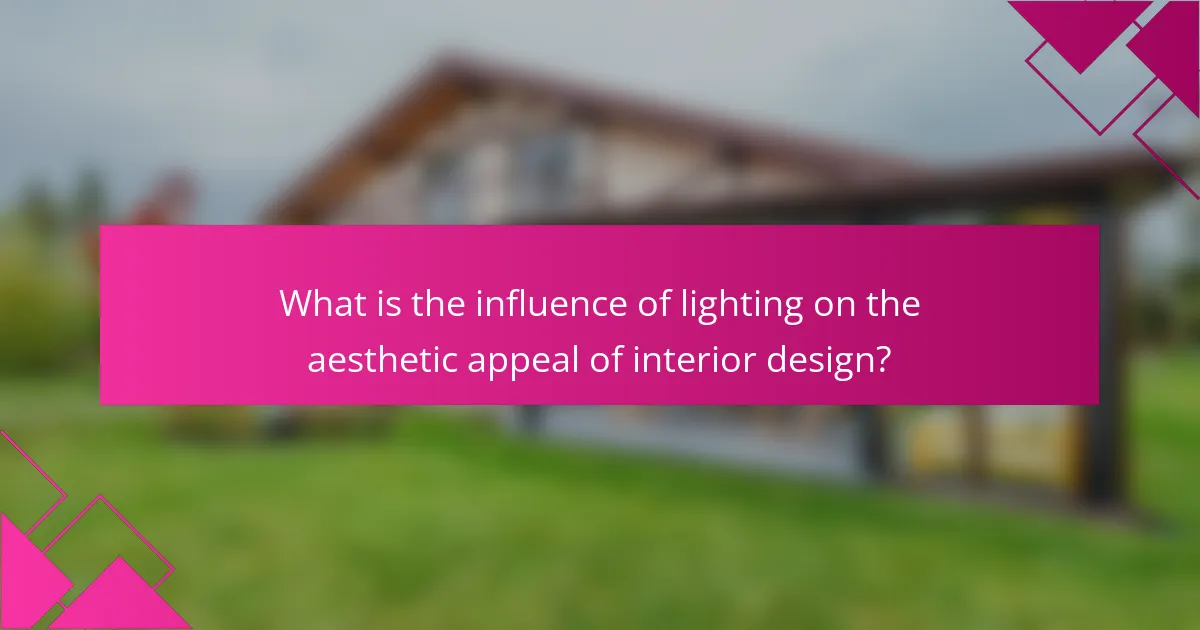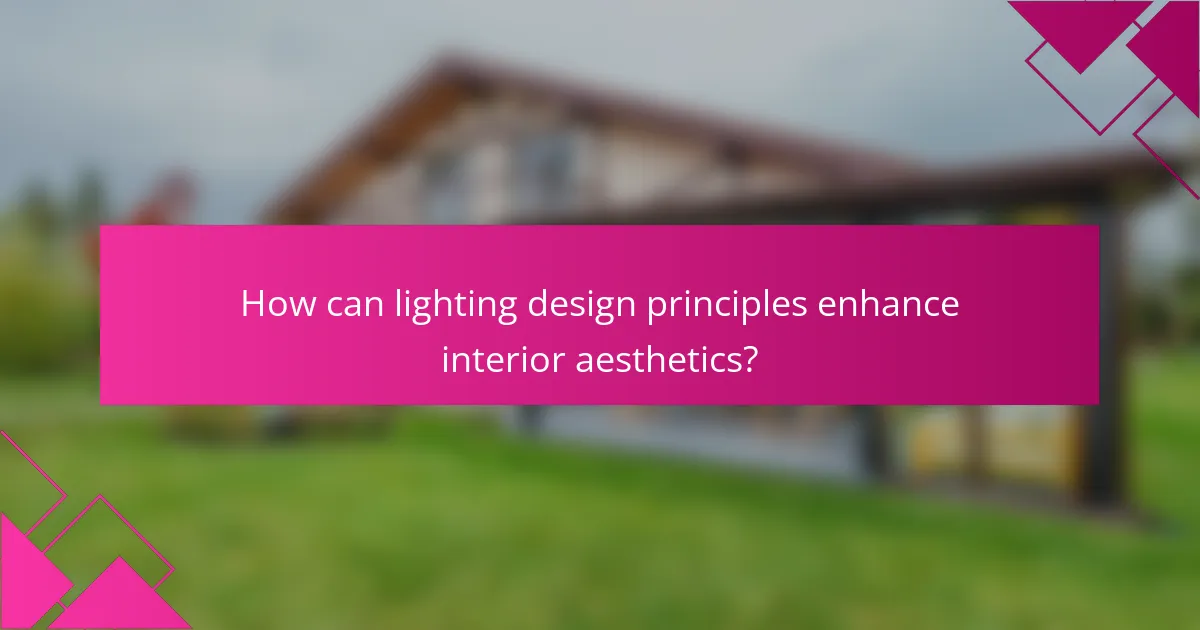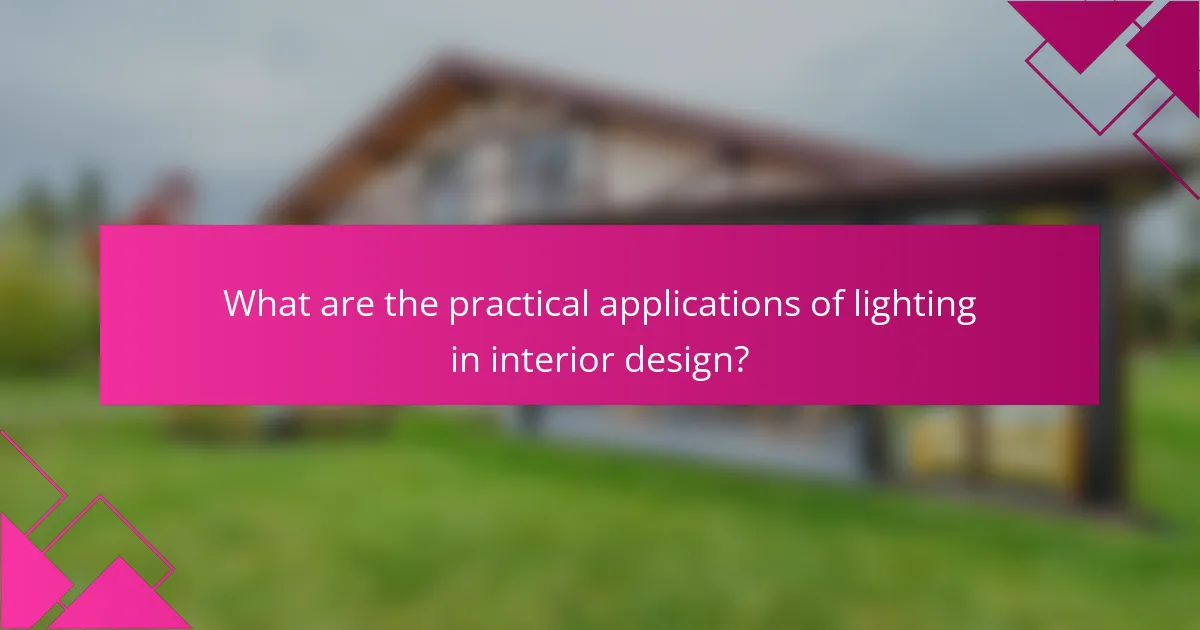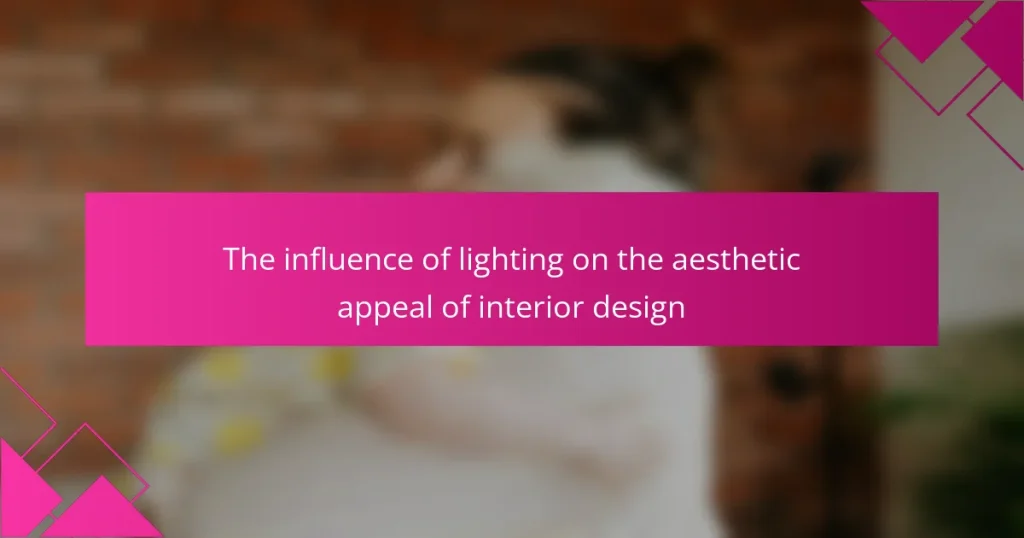Lighting plays a crucial role in the aesthetic appeal of interior design, influencing perceptions of space, color, and texture. It enhances architectural features and creates various ambiances through the use of natural and artificial light. Different lighting types, including ambient, task, and accent lighting, serve specific functions that can affect comfort, mood, and emotional responses in a space. Effective lighting design not only improves visibility but also increases the overall satisfaction and productivity of occupants, making it an essential element in creating inviting and functional interiors.

What is the influence of lighting on the aesthetic appeal of interior design?
Lighting significantly influences the aesthetic appeal of interior design. It affects the perception of space, color, and texture. Proper lighting can enhance architectural features and create ambiance. Natural light can make spaces feel larger and more inviting. Artificial lighting adds versatility and mood to a room. Different lighting types, such as ambient, task, and accent, serve distinct purposes. For example, ambient lighting provides overall illumination, while accent lighting highlights specific elements. Research shows that well-designed lighting can increase a room’s visual interest and comfort. Studies indicate that lighting impacts human emotions and behaviors, influencing how spaces are experienced.
How does lighting affect the perception of space in interior design?
Lighting significantly affects the perception of space in interior design. It can create an illusion of depth and dimension. Bright lighting can make a room feel larger and more open. Conversely, dim lighting can create a sense of intimacy and coziness. Different colors of light also influence perception. Warm light can make a space feel inviting, while cool light can make it feel more spacious. The placement of lighting fixtures affects how space is experienced. For example, upward lighting can enhance ceiling height. Studies show that well-designed lighting can improve mood and functionality in a space.
What are the different types of lighting used in interior design?
The different types of lighting used in interior design include ambient, task, and accent lighting. Ambient lighting provides overall illumination for a space. It creates a comfortable level of brightness without causing glare. Task lighting focuses on specific areas for activities like reading or cooking. It is often brighter and more direct than ambient lighting. Accent lighting highlights particular features or decor, such as artwork or architectural details. This type of lighting adds depth and interest to a room. Each type plays a crucial role in enhancing the aesthetic appeal of interior spaces.
How does natural light differ from artificial light in design contexts?
Natural light differs from artificial light in design contexts primarily in quality and effect. Natural light is dynamic, changing in intensity and color throughout the day. It provides a spectrum of colors that can enhance the perception of space. In contrast, artificial light is static and can be controlled for specific tasks. Artificial light sources often emit a limited color range, which can affect mood and ambiance. Studies show that spaces illuminated by natural light can improve well-being and productivity. Additionally, natural light can create shadows and highlights, adding depth to design. Artificial light, while versatile, may lack the warmth and vibrancy of daylight.
Why is lighting considered a crucial element in enhancing aesthetics?
Lighting is considered a crucial element in enhancing aesthetics because it influences the perception of space and color. Proper lighting can create mood and highlight architectural features. It affects how textures and materials are viewed, enhancing their appeal. Natural light has been shown to improve mental well-being and productivity. According to a study by the American Society of Interior Designers, well-lit environments are linked to higher user satisfaction. Different lighting types, such as ambient, task, and accent, serve specific aesthetic purposes. Each type can transform the atmosphere of a room. Thus, effective lighting design is essential for achieving desired aesthetic outcomes in interior spaces.
What psychological effects does lighting have on individuals in a space?
Lighting significantly impacts individuals’ psychological states in a space. Bright lighting can enhance alertness and improve mood. Conversely, dim lighting often creates a calming atmosphere, promoting relaxation. Studies show that natural light exposure can boost serotonin levels, contributing to a sense of well-being. In contrast, harsh artificial lighting may lead to feelings of anxiety or discomfort. Color temperature also plays a role; warm light is associated with comfort, while cool light can increase focus. Additionally, lighting design influences social interactions, with well-lit spaces encouraging communication. Overall, the psychological effects of lighting are profound and multifaceted.
How can lighting influence color perception in interior design?
Lighting significantly influences color perception in interior design. Different light sources emit varying color temperatures, which can alter how colors appear. For example, warm lighting can make colors look softer and more inviting. In contrast, cool lighting can enhance the vibrancy and saturation of colors.
Natural light changes throughout the day, affecting color perception in a space. During the morning, colors may appear more muted, while afternoon light can make them look more vivid. The use of artificial lighting, such as LED or incandescent bulbs, also impacts color appearance.
Research from the Lighting Research Center indicates that color temperature can affect mood and perception of space. A study by researchers at the University of California found that colors under different light sources can appear up to 20% different. This variability highlights the importance of selecting appropriate lighting to achieve desired color effects in interior design.
What role does lighting play in creating ambiance and mood?
Lighting significantly influences ambiance and mood in interior design. It affects how colors are perceived and can alter spatial perception. Bright lighting often creates a lively and energetic atmosphere. Conversely, dim lighting fosters a calm and intimate environment. Different light sources, such as natural light, incandescent, or LED, contribute unique qualities. For example, warm light can evoke comfort, while cool light may enhance focus. Studies show that lighting can impact emotions and behavior, influencing productivity and relaxation. Therefore, the strategic use of lighting is crucial in creating desired atmospheres in interior spaces.
What lighting techniques can be used to achieve specific atmospheres?
Lighting techniques include ambient, task, accent, and decorative lighting. Ambient lighting provides overall illumination and sets the mood of a space. Task lighting focuses on specific areas for activities like reading or cooking. Accent lighting highlights particular features, such as artwork or architectural elements. Decorative lighting adds visual interest through unique fixtures.
Using warm tones creates a cozy atmosphere. Bright, cool lights can enhance productivity in workspaces. Layering different lighting types adds depth and dimension to a room. Dimming capabilities allow for customizable atmospheres. Historical studies show that lighting significantly affects emotional responses and perceptions of space.
How do different lighting styles contribute to various design themes?
Different lighting styles significantly shape various design themes. Ambient lighting creates a warm, inviting atmosphere, essential for cozy spaces. Task lighting focuses on functionality, enhancing areas like kitchens and offices. Accent lighting highlights artwork or architectural features, adding depth to modern designs. Natural lighting fosters a connection to the outdoors, promoting well-being in minimalist themes. Each lighting style aligns with design principles, influencing mood and perception. For instance, soft, diffused light suits rustic themes, while sharp, direct light complements industrial aesthetics. The interplay of lighting styles and design themes is crucial for achieving desired emotional responses in interior spaces.

How can lighting design principles enhance interior aesthetics?
Lighting design principles can significantly enhance interior aesthetics by improving visibility and creating mood. Proper lighting highlights architectural features and decor elements. It influences color perception and spatial awareness. For example, warm lighting can create a cozy atmosphere, while cool lighting can evoke a modern feel. Layered lighting, which includes ambient, task, and accent lighting, adds depth and dimension to spaces. Studies show that well-designed lighting can increase comfort and satisfaction in a room. According to the American Society of Interior Designers, effective lighting design is essential for enhancing the overall aesthetic appeal of interiors.
What are the key principles of effective lighting design?
The key principles of effective lighting design include functionality, aesthetics, and adaptability. Functionality ensures that lighting meets the practical needs of the space. Aesthetics enhances the visual appeal and mood of the environment. Adaptability allows for changes in lighting based on different activities or times of day.
Additionally, layering light sources is crucial. This involves combining ambient, task, and accent lighting to create depth and interest. Color temperature also plays a significant role. Warmer tones create a cozy atmosphere, while cooler tones promote alertness.
Finally, energy efficiency is an important consideration. Using LED fixtures can significantly reduce energy consumption. These principles collectively contribute to a well-designed lighting scheme that enhances interior spaces.
How does layering light improve the overall design?
Layering light enhances overall design by creating depth and dimension in a space. It involves combining ambient, task, and accent lighting. Ambient lighting provides general illumination, making the area feel welcoming. Task lighting focuses on specific activities, improving functionality. Accent lighting highlights features, adding visual interest. This combination allows for flexibility in mood and atmosphere. According to the American Society of Interior Designers, well-layered lighting can significantly improve the perceived size and comfort of a room. Effective layering also promotes energy efficiency by allowing for targeted lighting use.
What is the importance of scale and proportion in lighting design?
Scale and proportion are critical in lighting design as they affect the overall harmony and functionality of a space. Proper scale ensures that lighting fixtures are appropriately sized for the room, enhancing visual balance. Proportion relates to the relationship between fixtures and the surrounding elements, contributing to a cohesive design. When lighting is scaled correctly, it can highlight architectural features and create a sense of space. For instance, large fixtures in a small room can overwhelm, while small fixtures in a large space may fail to provide adequate illumination. Research indicates that well-scaled lighting can improve the perceived size and comfort of a room, enhancing its aesthetic appeal.
How does the choice of fixtures impact aesthetic appeal?
The choice of fixtures significantly impacts aesthetic appeal in interior design. Fixtures define the style and ambiance of a space. For example, modern fixtures can create a sleek and contemporary look. Conversely, vintage fixtures may evoke a sense of nostalgia and warmth. The material of fixtures, such as metal or glass, also influences visual texture. Additionally, the size and scale of fixtures must complement the room’s proportions. Properly selected fixtures enhance the overall design theme. Research shows that lighting fixtures can affect mood and perception of space. Therefore, thoughtful fixture selection is essential for achieving desired aesthetics.
What factors should be considered when selecting lighting fixtures?
When selecting lighting fixtures, consider functionality, style, and energy efficiency. Functionality refers to how well the fixture meets the lighting needs of the space. Different areas require different types of lighting, such as ambient, task, or accent lighting. Style encompasses the design and aesthetics of the fixture, which should complement the overall interior design. Energy efficiency is essential for reducing energy consumption and costs. Choosing LED fixtures can significantly lower energy usage compared to traditional bulbs. Additionally, consider the size and scale of the fixture in relation to the space. Proper sizing ensures that the lighting is proportionate and visually appealing. Lastly, assess the color temperature of the light, as it affects the ambiance and mood of the room. Warm white light creates a cozy atmosphere, while cool white light can enhance focus and productivity.
How can fixture design complement the overall interior style?
Fixture design can enhance the overall interior style by aligning with the chosen aesthetic. Thoughtfully selected fixtures can echo the color palette and materials used in the space. For example, sleek metal fixtures complement modern designs, while ornate fixtures enhance traditional aesthetics. The scale of fixtures also plays a crucial role; oversized fixtures can serve as focal points in spacious rooms. Additionally, the style of the fixtures should harmonize with furniture and decor to create a cohesive look. Research indicates that well-designed lighting can improve mood and perception of space, further validating the importance of fixture design in interior styling.
What are the common mistakes to avoid in lighting design?
Common mistakes to avoid in lighting design include inadequate layering of light. Relying solely on ambient lighting can create flat spaces. Failing to consider the purpose of each room leads to ineffective lighting choices. Ignoring the color temperature can affect the mood and functionality of a space. Overlooking the importance of dimmers can limit flexibility in lighting control. Neglecting to account for natural light can result in harsh contrasts. Using fixtures that do not complement the interior style can disrupt aesthetics. Lastly, improper placement of fixtures can create shadows and glare, detracting from visual appeal.
How can improper lighting affect the aesthetic of a space?
Improper lighting can significantly detract from the aesthetic of a space. It can create unflattering shadows and highlight undesirable features. Poorly placed or inadequate lighting can make a room feel smaller or more cramped. Inadequate brightness can lead to a dull and lifeless atmosphere. Conversely, overly bright lighting can cause glare and discomfort. The color temperature of lighting affects how colors are perceived in a space. For instance, warm lighting can enhance cozy feelings, while cool lighting can create a more sterile environment. Studies show that lighting influences mood and perception, impacting how individuals experience a space. Proper lighting design is essential for achieving the desired aesthetic appeal in interior design.
What strategies can be used to rectify poor lighting choices?
To rectify poor lighting choices, consider adjusting the light sources and their placement. Replacing harsh bulbs with softer, warmer options enhances comfort. Layering different types of lighting, such as ambient, task, and accent, creates depth. Utilizing dimmer switches allows for adjustable brightness based on the time of day. Incorporating reflective surfaces can amplify natural light and improve overall illumination. Additionally, using lampshades or diffusers softens direct light and reduces glare. Finally, reassessing the color temperature of the bulbs can significantly impact the room’s mood and aesthetic appeal. These strategies collectively improve the lighting quality and enhance the interior design.

What are the practical applications of lighting in interior design?
Lighting in interior design serves multiple practical applications. It enhances the ambiance of a space. Different types of lighting can create various moods. For example, soft lighting promotes relaxation. Bright lighting is ideal for workspaces. Task lighting focuses on specific areas for activities like reading. Accent lighting highlights artwork or architectural features. Natural light integration improves energy efficiency and well-being. According to the American Society of Interior Designers, proper lighting can increase productivity and comfort in work environments.
How can lighting be used to highlight architectural features?
Lighting can be used to highlight architectural features by strategically directing light to emphasize shapes and textures. This technique enhances visual interest and depth in a space. For example, uplighting can accentuate columns and arches, creating dramatic shadows. Downlighting can illuminate intricate details like moldings and carvings, drawing attention to craftsmanship. Additionally, colored lighting can transform surfaces, altering perception and mood. According to the American Institute of Architects, effective lighting design can significantly enhance the aesthetic value of architectural elements. Proper placement and intensity of light can create focal points, guiding the viewer’s eye throughout the interior.
What techniques are effective for accentuating artwork and decor?
Effective techniques for accentuating artwork and decor include strategic lighting, color contrast, and framing. Proper lighting enhances the visibility and emotional impact of artwork. For instance, spotlighting can draw attention to specific pieces. Color contrast between the artwork and the wall can create visual interest. Using complementary colors can make the artwork stand out. Additionally, appropriate framing can add depth and context to the piece. Frames should match the decor style to maintain harmony. These techniques collectively enhance the aesthetic appeal of interior design.
How does lighting enhance functionality in different areas of a home?
Lighting enhances functionality in different areas of a home by providing adequate illumination for specific tasks. In kitchens, bright lighting facilitates cooking and food preparation. In living rooms, softer lighting creates a cozy atmosphere for relaxation. Bedrooms benefit from adjustable lighting to support reading or restful sleep. In home offices, focused lighting boosts productivity and reduces eye strain. Effective lighting design also emphasizes safety by illuminating stairways and hallways. According to the American Lighting Association, well-planned lighting can improve overall well-being and efficiency in daily activities. Proper lighting choices can significantly impact how spaces are used and perceived.
What are some innovative lighting solutions for modern interiors?
Innovative lighting solutions for modern interiors include LED strip lights, smart lighting, and pendant fixtures. LED strip lights offer versatility in placement and can be used to create ambient lighting. Smart lighting systems allow users to control brightness and color through mobile apps or voice commands. Pendant fixtures provide a stylish focal point above dining areas or kitchen islands. Additionally, recessed lighting creates a clean, unobtrusive look while highlighting architectural features. Each solution enhances the aesthetic appeal of spaces by providing tailored illumination. These options are popular in contemporary designs, reflecting trends in functionality and style.
How can smart lighting technology improve aesthetic appeal?
Smart lighting technology enhances aesthetic appeal by allowing dynamic control over light intensity and color. This flexibility helps create various moods and atmospheres in a space. For instance, adjustable color temperatures can mimic natural light, making interiors feel more inviting. Smart lighting can also highlight architectural features and artwork, drawing attention to specific areas. Moreover, programmable lighting scenes can transform a room for different occasions, enhancing its functionality and visual interest. Studies indicate that well-designed lighting can increase perceived space and improve overall ambiance, making environments more enjoyable and visually appealing.
What are the benefits of using LED lighting in design?
LED lighting offers several benefits in design. It is energy-efficient, consuming up to 75% less energy than traditional incandescent bulbs. This efficiency translates to lower electricity bills and reduced environmental impact. LED lights have a longer lifespan, lasting up to 25,000 hours compared to 1,000 hours for incandescent bulbs. This longevity reduces the frequency of replacements, saving time and resources.
Additionally, LED lighting provides better color accuracy and brightness control. Designers can achieve desired moods and aesthetics by adjusting color temperatures. LEDs also emit less heat, minimizing the risk of heat damage to interior elements. Their compact size allows for versatile installation options in various design settings. Overall, these attributes make LED lighting a preferred choice for enhancing the aesthetic appeal of interior spaces.
What tips can be implemented for effective lighting design in interiors?
Effective lighting design in interiors can be achieved through several key tips. First, layer lighting by combining ambient, task, and accent lighting. This approach creates depth and versatility in the space. Second, consider the color temperature of light bulbs. Warmer tones often enhance comfort, while cooler tones can energize a room. Third, utilize dimmers to adjust brightness according to the time of day or activity. This flexibility adds functionality to the lighting scheme. Fourth, focus on the placement of light sources. Positioning lights at different heights can reduce shadows and highlight architectural features. Fifth, select fixtures that complement the room’s style. This ensures cohesiveness in design. Lastly, maximize natural light by using mirrors and light-colored surfaces to reflect illumination. Research shows that well-planned lighting can improve mood and productivity in interior spaces.
How can homeowners choose the right lighting for their spaces?
Homeowners can choose the right lighting by assessing the function of each space. Different rooms require different lighting types. For example, task lighting is essential in kitchens and offices. Ambient lighting creates a warm atmosphere in living rooms and bedrooms. Homeowners should consider the color temperature of bulbs. Warmer tones (2700K-3000K) create a cozy feel. Cooler tones (4000K-5000K) are better for workspaces. Layering lighting is also important. Combining ambient, task, and accent lighting enhances the overall design. Homeowners should evaluate the size and layout of their rooms. Larger spaces may need multiple light sources for even distribution. Finally, personal style should guide choices. Selecting fixtures that match decor enhances aesthetic appeal.
What best practices should be followed for layering light effectively?
To layer light effectively, use a combination of ambient, task, and accent lighting. Ambient lighting provides overall illumination and sets the mood. Task lighting focuses on specific areas for activities like reading or cooking. Accent lighting highlights artwork or architectural features. Use dimmers to adjust light levels for different occasions. Choose light fixtures that complement the room’s design. Consider the color temperature of the bulbs; warmer tones create a cozy atmosphere. Finally, ensure that light sources are positioned to minimize shadows and glare. These practices enhance the aesthetic appeal of interior spaces by creating depth and interest.
The main entity of the article is lighting and its influence on the aesthetic appeal of interior design. The article explores how lighting affects the perception of space, color, and texture, highlighting the importance of natural and artificial lighting in creating ambiance. It details various lighting types—ambient, task, and accent—and their specific roles in enhancing visual interest and functionality within different interior spaces. Additionally, the article discusses the psychological effects of lighting on individuals and provides practical applications and best practices for effective lighting design to achieve desired aesthetic outcomes.


